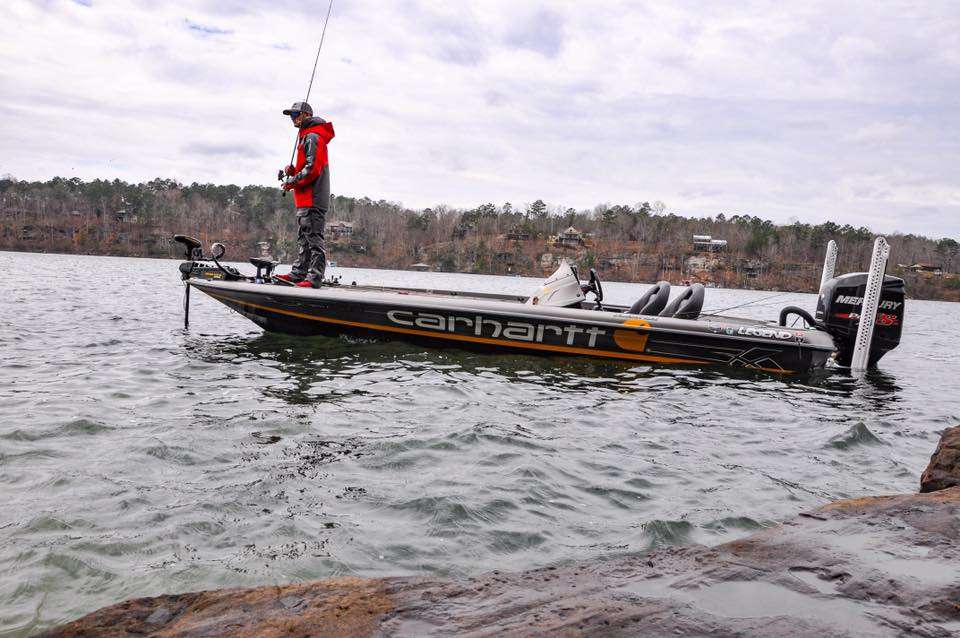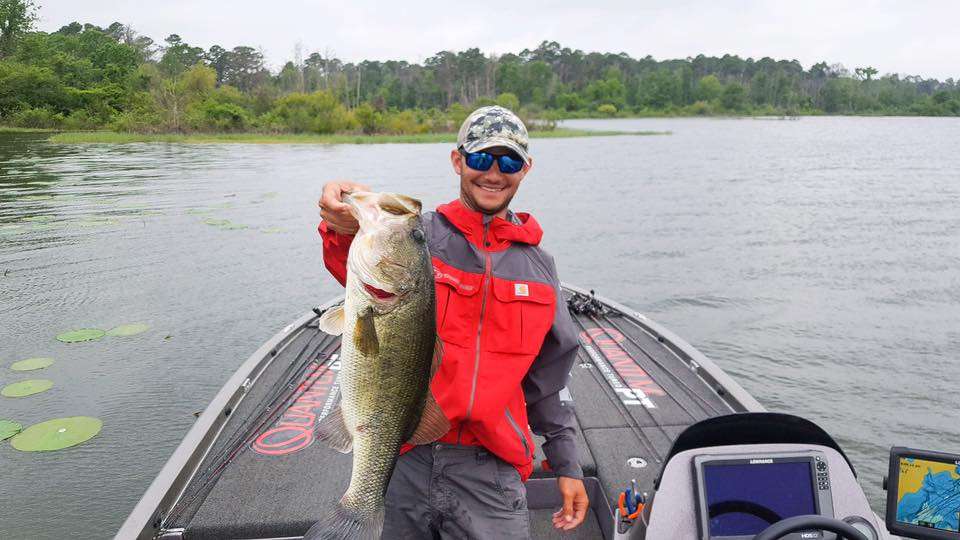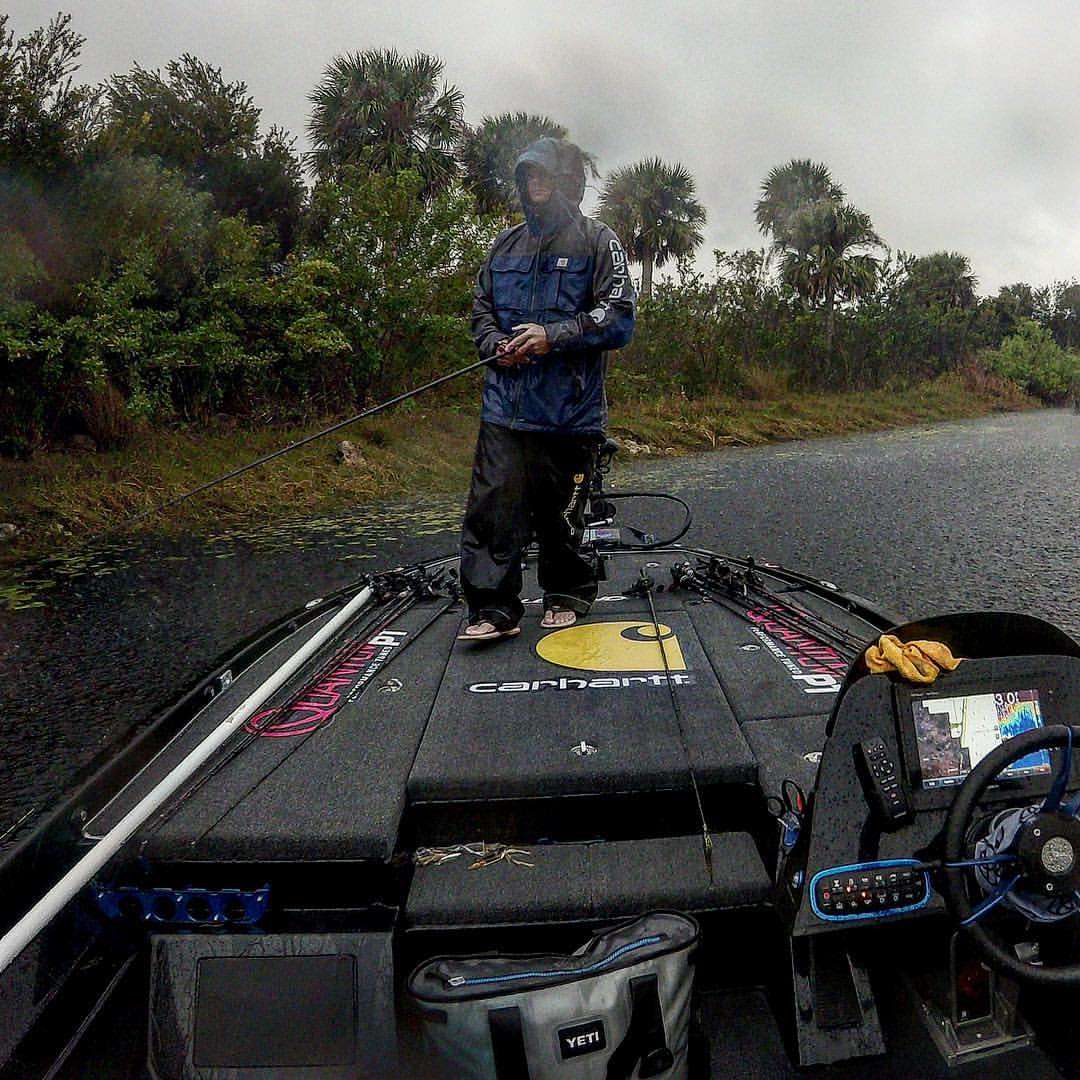
It’s been a long summer. We’ve all spent our share of days, with rod and reel in hand, catching more sunburns than bass. Relief is on the way, though, as more frequent fronts and cooler nights have water temps falling on your local fishery. Baitfish are on the move, and the words “fall feed bag” are starting to float around our heads. There’s a storm coming, and bass fishermen everywhere are ready.
Dramatic temperature drops that trigger fall feeding usually arrive with a storm
of their own. Wind. Intermittent drizzle. Rain. Downpour. Sleet. Snow. The bass don’t stop for foul weather, and neither should you. We recently picked the brains of reigning Bassmaster Classic Champ Jordan Lee and his brother Matt — both hot off back-to-back top 12 finishes on a windy, stormy Lake Champlain and Lake St. Clair — on everything from how to prepare before launching your boat in foul weather to tactics that’ll help you boat more bass when conditions turn snotty.
The Boat
In recent memory, neither Matt nor Jordan can remember a time when an Elite Series practice has been called off. In their world, fishing and tournament practice are truly rain-or-shine events. To prepare for the worst, the two spend extra time on boat prep.
Matt has made significant changes to his preparation after his first season fishing the Opens:
“Back when I fished the Opens, I sometimes didn’t have a clue as to how a lake would be affected by high winds or storms,” says the older Lee. “When I was running my old boat, there were a few occasions after a long day in rough water I’d find nuts and bolts laying around the bottom of the boat with no clue where they’d come from.
[Gerald] Swindle also helped me a lot. He turned me onto some course screws that he used that hold up better to a beating. On top of the screw change, I make note to go through my boat and tighten everything I can before heading out on rough water. A ten-minute check can add years to the life of your equipment.”
Both Lee’s rely on heavy-duty hardware. Jordan walked us through a checklist of additional equipment that has become standard on his rig.
“Technology gets better year after year. Some items, like the T-H Marine Kong Mount, are a must for keeping my graphs rock solid,” he says. “Having a trolling motor that’s got the right amount of power for your size boat is also important. Some of them, like the new Minn Kota Ultrex, have the Spot-Lock feature, which is a huge help on windy days.
“Then there are the precautionary items. My boat always has two bilge pumps in case one fails. I’ve also got two straps on my trolling motor. I’ve learned the hard way about the importance of having backups.”
Your driving style can make a big difference, too. Both anglers say keeping it slow is the safest way to navigate through rough water. Right around 20 mph keeps thing slow enough to prevent too much wear and tear.
The Clothes
An angler’s comfort level can make or break a day of fishing. Give the same attention to your clothing as you do your boat and you’ll be able to stay on the water longer.
“As far as rain gear goes, it’s getting better and better every year,” says Matt. “My Carhartt Force Extreme Shoreline Angler rain suit does a great job of keeping me dry. If I plan my layers right it works just as well in a hot summer storm as it does in the cold winter months.”
However, the best rain gear in the world can’t help you if you fall in the lake or take a wave over the bow. Even in the summer, being wet all day can prevent you from focusing on the fish. Elite Series anglers can’t afford the time it takes to get off the water to change clothes. For that reason, both Lee brothers take a full change of clothes along with them, even during practice. They bring everything from socks and underwear to spare jeans and an extra Force t-shirt.
“It’s all about a backup plan,” Jordan says. “When I’ve got extra time left in practice I need to be ready to capitalize on every minute I can. There’s no room for error in being wet and cold.”

The Apps
When it comes to weather apps, Matt is a guru. He walked us through the smartphone tools that help him plan a day on the water:
“I use six different weather apps to get the best idea of what I can expect before heading out,” he says. “One I’ve really started to use a lot is called Windy. It’s got weather and wind stations scattered around that give you a very accurate look at what the wind will be doing hour by hour, both steady wind speed and gusts.
“I’ve got a couple radar apps that send me notifications when severe weather is rolling in. Like most people, I’m not on my phone very much while on the water. Having multiple alerts can be crucial.”
On bigger lakes, a midday change of wind direction can be the difference between having two- and four-foot waves. A large lake that runs north and south will become more dangerous in direct north and south winds. Having a good idea of what changes in wind direction can be vital to a safe and successful day.
The Fish
Unfortunately, there’s no golden rule that dictates how fish respond to foul weather. Fish behavior varies greatly from lake to lake and region to region. Jordan is quick to point out that weather usually makes things harder on the angler than it does the fish. That said, there are a few takeaways the Lee brothers have noticed. In particular, Matt believes the line diameter and weight size play a role during adverse weather.
“The flatter, and clearer the water, the better look a fish gets at your bait,” he says. “Even on the St. Lawrence River, where fish may have never seen a bait before, they got very finicky in calm and clear conditions. If I’m getting bit on a 1/4-ounce tube with high skies and sun, added cloud cover and wind can allow me to size up to a 1/2-ounce weight and bigger line. On Champlain, I had to switch from a 3/8-ounce drop shot to a wacky-rigged Strike King Ocho. The slower fall and lighter presentation picked up a few more bites for me.”
Jordan reiterates that it’s not a sound science. Finesse tactics can work well in stormy conditions, but cloud cover and wind can ignite reaction bait bites too.
“You can trick fish a lot easier with a little bit of wind, cloud cover, or rain,” says Jordan. “The key is that those conditions break up the surface to make it that much harder for the fish to get a good look at the bait. You’ll realize you’re able to get a few more reaction strikes.”
The Spots
When it comes to deciding where to start on a lake, Matt credits his college fishing career for helping mold his approach.
“Not getting help in college, and having to go to a lake, rain or shine, and figure it out gives me a distinct advantage when fishing new bodies of water like we do on the Elites,” he says. “It’s all about making adjustments on the fly. Fish move around a lot more in the wind and cloud cover, so you’ve got to move with them. Pay attention to whether you’re getting bites on wind-blown banks or points, or if calmer waters produce. Then try to build upon those areas and clues.”
If you’re fishing from a smaller boat, or if the size of the waves prevents you from driving safely to a spot, Jordan points out there’s always a safe haven.
“In extremely bad weather and wind, you can almost always find a part of the lake that’s somewhat sheltered,” he says. “Whether its a creek arm or a section of the lake blocked by the wind, you can usually take your boat out and put in at a ramp near a protected area.”
In short, don’t let foul weather keep you off the water. Where you launch your boat and your willingness to fish protected areas can salvage an otherwise tough day.

The Choice
It doesn’t matter whether you’re fishing for fun or for a $100,000 payday, make sure safety is the priority when making decisions on the water.
Looking back at the 2016 Elite Series event on the Mississippi River, Matt and Jordan made two different decisions as a storm cell with 40-plus mph winds barreled down on their tournament day.
“I remember being on the Minnesota side of the river with four fish in the well,” Matt recalls. “With the storm rolling up on us, I needed to decide whether to stay in Minnesota waters and try to catch a 2.5 pounder that would land me safely inside the cut, or run back to the Wisconsin side. I decided to ride it out and caught what I needed. With money on the line, it turned out to be the right decision.”
Jordan, who was in contention to win and on Bassmaster LIVE, decided otherwise.
“Even if it’s blowing 200mph, I’ve never not fished,” he jokes. “But when that storm came through, I made the decision to head to the bank. With lightening around and the winds as bad as they were, I just felt like it was the right call. It ended up taking an hour and a half of fishing time away from me. I know Matt ground it out and caught some fish, but for me, I felt I made the right decision.”
There’s no rulebook to follow when on the water in a storm. But if you’ve taken the time to get your boat and gear prepared, your instincts and erring on the side of caution will help keep you safe and on the fish.
